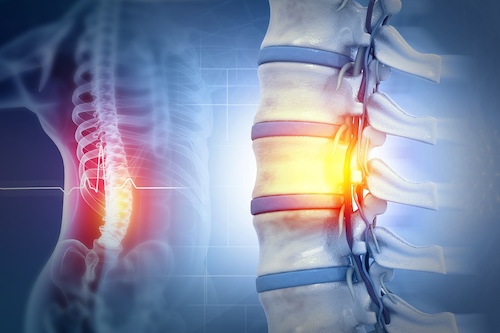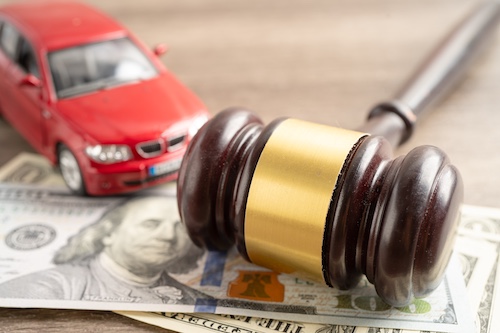Spinal Cord Injuries in Car Accidents
At NC Car Accident Lawyers, we represent people injured in car accidents across North Carolina. Our team investigates every detail, gathers medical records and expert evidence, and negotiates directly with insurers to pursue maximum compensation. We handle claims for medical expenses, rehabilitation, lost income, and pain and suffering. You pay nothing unless we win your case. Our mission is simple: to help you recover, rebuild, and move forward with confidence.
Spinal cord injuries are among the most severe outcomes of car accidents in North Carolina. Damage to the spinal cord can disrupt the body’s ability to control movement, sensation, and essential functions. These injuries often lead to lasting physical, emotional, and financial challenges for victims and their families.
Understanding how spinal cord injuries occur, recognizing symptoms early, and seeking prompt medical and legal help can make a critical difference in recovery. A Raleigh car accident lawyer can help injured individuals pursue compensation and secure the care needed for long-term rehabilitation and stability.
Understanding Spinal Cord Injuries
Spinal cord injuries are among the most serious outcomes of motor vehicle accidents. They can cause lasting damage to the spinal cord, affecting movement, sensation, and essential body functions.
What Is a Spinal Cord Injury?
A spinal cord injury occurs when the spinal cord or spinal nerves are damaged. The spinal cord carries signals between the brain and the rest of the body. When these nerve fibers are injured, the result can be partial or complete loss of motor or sensory function below the injury site. This loss may affect movement, sensation, bladder control, bowel function, and even blood pressure regulation.
Complete and Incomplete Injuries
Doctors classify spinal cord injuries as complete or incomplete. A complete injury means total loss of function and sensation below the affected area. An incomplete injury means that some motor or sensory signals still pass through the damaged area. The level of injury, whether in the cervical, thoracic, or lumbar spine, determines which parts of the body are affected.
Common Types of Spinal Cord Damage
Car accidents often cause different types of spinal cord damage, including:
- Central cord syndrome: affects nerve fibers that control movement in the arms and hands.
- Anterior cord syndrome: damages the front of the spinal cord, leading to impaired motor function and loss of pain and temperature sensation.
- Cauda equina syndrome: affects the bundle of nerve roots at the lower end of the spinal canal and can cause bowel, bladder, and sexual function problems.
The Role of the Spinal Column and Nerves
The spinal column protects the spinal cord and its nerve roots. These spinal nerves exit through spaces between vertebrae to carry messages to the rest of the body. Damage to the cervical spine can lead to paralysis in the arms and legs. Injury to the thoracic or lumbar vertebra may affect the chest muscles or lower body. Even a minor injury can lead to serious spinal cord trauma if not treated promptly.
How Car Accidents Cause Spinal Cord Injuries
During a car crash, sudden force or impact can compress, twist, or fracture the spinal column. This movement can bruise or sever spinal cord tissue, disrupt nerve cells, and limit blood flow to the spinal cord. Rear-end collisions, rollovers, and high-speed impacts are leading causes of spinal cord injuries in motor vehicle accidents.
Long-Term Impact
Spinal cord injuries can lead to temporary or permanent changes in how the nervous system functions. Many patients experience chronic pain, pressure sores, urinary tract infections, and blood clots. Recovery often requires spinal cord injury rehabilitation, including physical and occupational therapy.
Causes of Spinal Cord Injuries in Car Accidents
Spinal cord injuries in car accidents often occur when sudden impact or force damages the spine, spinal cord, or surrounding nerves. These injuries vary in severity depending on the type of crash and how the body absorbs the impact.
High-Impact Collisions
High-speed crashes are a leading cause of spinal cord trauma. When two vehicles collide head-on, the body experiences intense acceleration and deceleration forces. This can fracture the spinal column or compress the spinal cord. The cervical spine and thoracic nerves are especially at risk in these collisions, often resulting in paralysis or loss of motor and sensory function.
Rear-End and Side-Impact Accidents
Rear-end collisions can cause violent neck movement that injures the cervical spine. This type of back or neck injury may lead to conditions such as whiplash, central cord syndrome, or cervical spinal cord damage. Side-impact or T-bone crashes can twist the spine and injure the spinal nerves or nerve roots, disrupting communication between the brain and body.
Rollover Accidents
Rollover accidents create multiple points of impact that can crush or bend the spine in several directions. Occupants may experience spinal cord compression, broken vertebrae, or dislocation within the spinal canal. Even with seatbelts and airbags, rollover forces can lead to incomplete injury or complete spinal cord injury (SCI), depending on how the spine absorbs the impact.
Seatbelt and Airbag Forces
While seatbelts and airbags save lives, they can also contribute to spinal cord damage under certain conditions. A tight seatbelt across the abdomen or chest can apply pressure to the lumbar spine or thoracic vertebra during a high-speed collision. Improperly positioned airbags may increase strain on the cervical nerves or cause sudden hyperextension of the neck.
Secondary Injuries After Impact
Not all spinal cord injuries occur at the moment of collision. Secondary injuries can develop when swelling, bleeding, or reduced blood flow puts extra pressure on the spinal cord. These complications can lead to further spinal cord damage, nerve fiber death, or reduced motor and sensory function. Emergency spinal motion restriction and prompt medical treatment help relieve pressure and prevent permanent loss.
Other Contributing Factors
Some spinal cord injuries are worsened by pre-existing spinal conditions such as spinal stenosis or weakened vertebrae. Risk factors like poor posture, previous neck injury, or degenerative disc disease may increase the chance of spinal cord trauma during a crash. Even minor injuries can progress into serious spinal cord damage if not treated quickly.
Recognizing the Symptoms of a Spinal Cord Injury
Recognizing spinal cord injury symptoms early can prevent further damage and improve recovery outcomes. Immediate medical care is critical when any signs of spinal cord trauma appear after a car accident.
Early Physical Symptoms
The first symptoms of a spinal cord injury often include pain, numbness, or weakness in the back, neck, or limbs. Many people feel a sudden loss of coordination or balance. Muscle spasms, tingling sensations, or reduced grip strength can signal nerve fiber damage within the spinal cord. A suspected spinal cord injury requires prompt evaluation, even if pain seems minor.
Loss of Motor or Sensory Function
Damage to the spinal cord or spinal nerves can interrupt communication between the brain and body. This disruption may cause partial or complete paralysis below the injury site. An incomplete injury allows some movement or feeling to remain, while a complete injury eliminates all motor and sensory function. The location of the injury, whether in the cervical, thoracic, or lumbar spine, determines which body parts are affected.
Autonomic and Internal Changes
Spinal cord injuries can affect more than movement and sensation. Many patients experience bowel and bladder dysfunction, loss of bladder control, or changes in sexual function. Low blood pressure, difficulty regulating body temperature, and irregular heart rate can also appear. These symptoms are common in injuries involving the cervical spinal cord or high thoracic injuries, where the nervous system loses normal control over internal organs.
Secondary Complications
After a spinal cord injury, secondary problems can develop as the body adjusts. Pressure sores, pressure ulcers, and deep vein thrombosis may occur due to limited movement. Urinary tract infections are frequent in patients who lose bladder control. Blood clots, muscle stiffness, and respiratory problems can also arise if chest muscles or lung function are affected. Early treatment and regular physical therapy can reduce these complications.
When to Seek Emergency Care
Any back or neck injury after a motor vehicle accident should be treated as a potential spinal cord injury. Warning signs include loss of sensation, weakness, difficulty breathing, or loss of bowel or bladder control. Medical professionals can use imaging tests to confirm the presence of spinal cord trauma and begin treatment quickly.
Diagnosis and Treatment
Accurate diagnosis and timely treatment of spinal cord injuries are essential to prevent further spinal cord damage and improve long-term recovery. Immediate medical attention helps reduce secondary injury and increases the chance of regaining motor and sensory function.
Diagnostic Evaluation
When doctors suspect a spinal cord injury, they begin with a detailed physical and neurological examination. They assess strength, reflexes, and sensory function to locate the level of injury along the spinal column. Imaging tests such as X-rays, CT scans, and MRI scans reveal fractures, dislocations, or compression of the spinal canal. These tools help identify whether the injury affects the cervical, thoracic, or lumbar spine and determine if there is bleeding or swelling around the spinal cord tissue.
Emergency Medical Care
Emergency responders use spinal motion restriction to prevent movement that could worsen spinal cord trauma. This may include neck collars or backboards to stabilize the spine. In the hospital, doctors focus on maintaining oxygen and blood pressure to keep the spinal cord supplied with blood. Intravenous fluids and medications are often given to reduce inflammation and relieve pressure on the spinal cord.
Surgical Treatment
Surgery is sometimes required to stabilize the spinal column and relieve pressure on the nerve roots or spinal nerves. Procedures may include removing bone fragments, repairing fractured vertebrae, or inserting metal rods or plates to keep the spine aligned. Surgery also helps prevent secondary injury caused by swelling or compression. The goal is to protect remaining nerve cells and preserve as much function as possible.
Rehabilitation and Recovery
After emergency care, spinal cord injury rehabilitation begins. This stage involves physical therapy, occupational therapy, and medical monitoring to restore movement and strength. Physical and occupational therapists help patients relearn daily activities and use assistive devices to maintain independence. Rehabilitation also addresses complications such as pressure sores, urinary tract infections, and muscle stiffness.
Ongoing Care and Complications
Recovery from a spinal cord injury requires long-term care and regular follow-up. Patients may experience blood clots, respiratory infections, and pressure injuries if mobility is limited. Managing bladder control, bowel function, and blood pressure becomes part of everyday life. Ongoing therapy focuses on improving functional recovery, preventing infections, and promoting adaptation to physical changes.
Contact an Experienced Raleigh Car Accident Attorney ASAP!
If you or a loved one has suffered spinal cord injuries in a car accident, do not wait. Reach out to our team at NC Car Accident Lawyers today. Our lawyers will review your case at no cost. We guide you through medical evidence, fight for full compensation, and stand by your side every step of the way.
Contact us at 864-561-6247 for a free claim review today!







